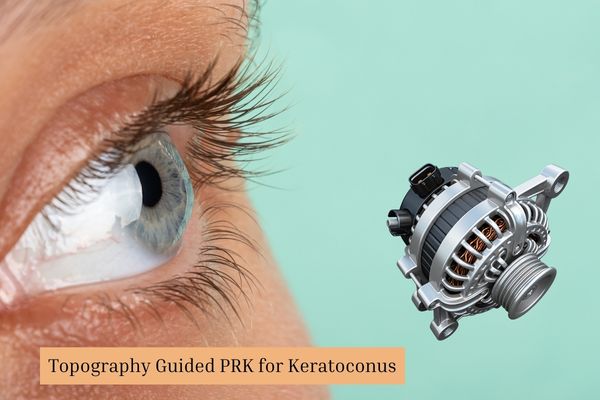Keratoconus is a progressive eye condition where the cornea, the clear outer layer of the eye, thins and bulges into a cone-like shape, leading to vision problems. This condition often begins in adolescence or early adulthood and can lead to significant visual impairment if not properly managed. In the UK, patients with keratoconus traditionally rely on glasses, contact lenses, corneal cross-linking, or in severe cases, corneal transplants. However, recent advancements in refractive surgery, particularly Topography Guided Photorefractive Keratectomy (PRK), have emerged as a potential treatment. This article explores whether Topography Guided PRK is a safer and more effective alternative for treating keratoconus in the UK.
What is Keratoconus and How Does It Affect Vision?
What is Topography Guided PRK?
Topography Guided PRK is a type of refractive surgery used to correct vision problems caused by corneal irregularities. In contrast to traditional PRK, which uses standard measurements for reshaping the cornea, Topography Guided PRK uses detailed corneal maps (generated using corneal topography) to customize the procedure. This method is designed to treat specific irregularities of the cornea caused by conditions like keratoconus, providing a more personalized and precise treatment.
How Does Topography Guided PRK Work for Keratoconus?

- Preoperative Mapping: The surgeon uses corneal topography to map the cornea’s surface.
- Customized Laser Treatment: The laser is programmed to treat the specific irregularities found in the cornea’s shape.
- Healing: After the procedure, the outer layer of the cornea (epithelium) grows back naturally, and patients typically experience improvement in vision over weeks to months.
Advantages of Topography Guided PRK for Keratoconus
- Personalized Treatment: The primary advantage of Topography Guided PRK is its ability to personalize treatment based on the unique shape and irregularities of each patient’s cornea. Unlike standard treatments, which use general measurements, this method accounts for the individual characteristics of the cornea, potentially leading to better visual outcomes.
- No Corneal Flap Required: Unlike LASIK, which requires the creation of a corneal flap, PRK (including Topography Guided PRK) removes the need for this step, making it suitable for patients with thinner corneas or those with irregular corneal shapes.
- Effective for Mild to Moderate Keratoconus: For patients with mild to moderate keratoconus, Topography Guided PRK offers a non-invasive alternative to traditional treatments like corneal cross-linking or corneal transplants.
- Improved Visual Quality: By addressing the irregularities caused by keratoconus, Topography Guided PRK may offer improved visual quality compared to standard methods, reducing the distortion caused by the disease.
- Safer than Corneal Transplant: For patients with severe keratoconus, corneal transplant surgery is typically recommended, but Topography Guided PRK provides a less invasive alternative that avoids the need for a transplant and its associated risks.
Testimonials
“Excellent manner, listens really well and gives multiple opportunities to ask questions, which is really helpful. Very calm, gently spoken and not rushed”
Considerations and Risks of Topography Guided PRK
While Topography Guided PRK has shown promising results, it is not without its considerations and risks.
- Not Suitable for Severe Keratoconus: For patients with advanced keratoconus, where the cornea has become too thin or scarred, Topography Guided PRK may not be effective. In such cases, more intensive treatments such as corneal cross-linking or a corneal transplant may be necessary.
- Recovery Time: Recovery after PRK, including Topography Guided PRK, is typically longer than with LASIK. Patients may experience discomfort in the first few days after surgery, and full visual recovery can take several weeks to months.
- Risk of Overcorrection or Under correction: While Topography Guided PRK allows for precise treatment, there is still a risk of overcorrection or under correction of vision. Regular follow-up visits are necessary to monitor the results and address any issues.
- Long-term Effectiveness: The long-term effectiveness of Topography Guided PRK in treating keratoconus is still being studied. While many patients experience improvements, there may be long-term challenges that arise as the condition progresses.
Is Topography Guided PRK a Safer Alternative for Keratoconus in the UK?
- For patients with early-stage keratoconus, Topography Guided PRK provides a personalized solution that can improve visual clarity without the need for more invasive treatments.
- For more advanced cases, this treatment may not be suitable, and corneal cross-linking or a corneal transplant might still be the preferred option.
